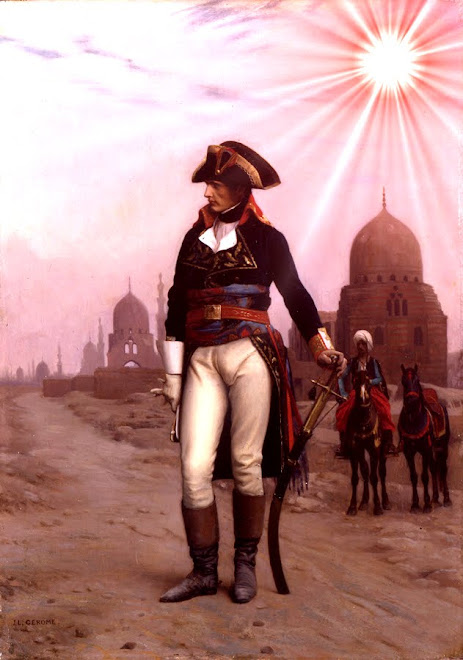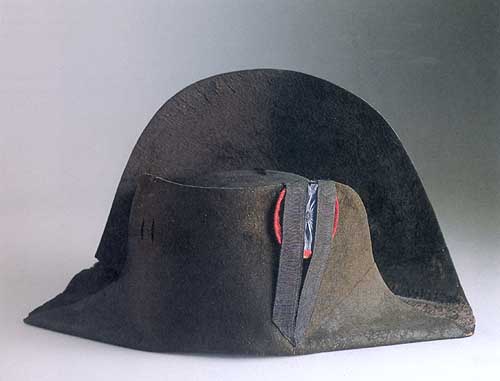AT THE BEREZINA RIVER Nov. 28th 1812
One of the most atmospheric and evocative paintings of the Great Retreat of Napoleon's Grand Army in 1812 was painted by the German artist Peter von Hess. What I particularly like about this painting is the fantastic detail and the all-encompassing sweep of the piece. Nothing escapes his masterly eye. Indeed there is so much of interest in this work that I have taken the liberty of enhancing different parts of the painting to demonstrate the wealth of information about the Retreat there is upon the canvas.
The story of the crossing of the Berezina is worthy of a Hollywood blockbuster yet it is a tale most people will never even have heard of. In England one is almost flushed with embarrassment at the constant references to Waterloo. In my country few have heard of Austerlitz - the Emperor's greatest triumph. Wellington defeated Napoleon in 1815 only with the assistance of the Prussians. In December 1805, Napoleon defeated Austria and Russia by himself. The young Tsar Alexander fled the battlefield in tears. Yet only two years later at Tilsit Napoleon treated him indulgently as if he had been his own younger brother.
Similarly, no one here speaks of the Berezina. Able was Eble before he saw this latterday River Styx. As Sergeant Bourgogne says: "We saw the brave pontonniers working hard at the bridges for us to cross. They had worked all night, standing up to their shoulders in ice-cold water, encouraged by their General (Eble). These brave men sacrificed their lives to save the army." When the first bridge was finished Marshal Oudinot crossed with his corps to prevent the Russians blocking the escape route. "On the next day (the 27th)...the Emperor crossed the Berezina with part of the Guard, and about a thousand men belonging to Marshal Ney's corps."
Now let's immerse ourselves in Hess's wonderful portrayal of these events. In the left centre is a doughty member of the Old Guard his musket levelled at the approaching Russians, his bayonet ready.
Perhaps his dark blue overcoat looks a little too clean because by this time many of the men were dressed in rags as Bourgogne and Coignet attest. However, some of the Old Guard made herculean efforts to present themselves as if on the parade ground no matter what was happening around them, despite the Arctic temperatures and the chaos endemic everywhere. A shattered tree indicates the bombardments that the survivors had to endure at the hand of the pursuing Russians. Around our brave grognard lie his compatriots, some about to expire. An abandoned cannon is close by. At this stage of the Retreat many of the horses that had been pulling the guns had been eaten by the starving troops. At Gara, where he witnessed a terrible barn fire that cremated dozens of men while they were still alive and taking shelter inside the building, Bourgogne reveals the dark secret that other wretched men ate some of the cooked flesh that resulted. He adds that by then many would have eaten the devil himself - had he been cooked.
At the bottom right can be seen a Cossack wearing an orange brown coat on horseback. He is dragging a prisoner along with him, a rope attaching the man to the rider can just be seen. Meanwhile another exhausted victim is rooted out from beneath an overturned cart at the point of his lance. Hess might well have been thinking of Bourgogne himself here because he mentions hiding beneath a cart to escape the terrible long lances of the Cossacks. Abandoned goods are seen strewn all over the battlefield. Many of the soldiers in the Grand Army had left Moscow weighed down with gold, jewels and other trophies. As the snows fell and the temperature plummeted these items were thrown away. Rich precious first editions of rare leather bound books could be seen in the snow, their pages fluttering in the wind. Instead, men fought each other for tiny items of food, stealing from those that only too recently had been their best friends. When a man stumbled and seemed about to face his maker he was stripped of his clothing, sometimes before he had even died.
Frenchmen and their Allies who became prisoners of the Cossacks and irregular troops often faced a dire situation. Some officers in the regular Russian army insisted on proprieties but many others simply refused to take prisoners. Inevitably, those captured were stripped naked and forced to march in the snow until they dropped dead or reached a benighted sanctuary in some makeshift prison camp. If the furious peasants got hold of them the outlook was even worse. Their Holy Mother Russia violated, the peasants had no thought of humanity or compassion. French throats were slit as if they were just more pigs being butchered for the table. The heads of prisoners were bashed in with atavistic glee, the executioners feeling no more compunction than they would have felt in the act of swatting an insect. Many stragglers received over a dozen stabs from Cossack lances and miraculously a few of these survived and managed to get all the way back to France!
In the extreme bottom right of the painting, a group of dying men remain motionless, too exhausted even to attempt to escape their vengeful pursuers. One man lies on the snow with his feet actually in the fire. This reflects awful incidents that actually took place. The men were so cold and frostbitten that they had lost all sense of feeling in their limbs, especially their feet. As a result they often smelt flesh burning without realizing it was their own body that was on fire. Soldiers being soldiers, they drank whatever intoxicating liquor was at hand. Having eaten little, only a few mouthfuls were enough to make them drunk. Despite having got as far as Vilna, far beyond the Berezina, hundreds of men died after imbibing, their bodies cluttering the streets. Boarded-up houses showed that the locals were too afraid to let these famished wraiths inside their homes.
Perhaps the most heart-rending accounts of these terrible days by the river concern ordinary civilians who had been caught up in the war. Many French tutors, musicians and actors who had been working in Moscow thought it best to leave the city with their compatriots - a bad mistake if ever there was one. The 'wives' of the soldiers also accompanied their 'husbands'. And there was a litany of washerwomen, prostitutes and others who swelled the ranks of the fleeing horde. Most would become victims on the long death march out of Russia.
At the extreme bottom left of the painting we see a young woman sprawled out in front of a fire, the flames of which are dying down and about to go out. In her arms she seems to be holding a baby. Hess had obviously read his Bourgogne, for the brave Sergeant recounted how one of the cantinieres gave birth only to find her infant frozen solid a few days later. A cuirassier stands nearby, his fallen horse at his feet and a comrade begging him for help. During the Retreat, starving women offered their bodies for morsels of food and were usually rejected. In their own eyes they might still have been the beautiful young women they had been before the Retreat. But after weeks of frozen terror with little to eat, their shrivelled breasts and washboard ribs were far from attractive and sex was the last thing on a dying soldier's mind.
At the Berezina, hundreds of civilians rushed to cross the two flimsy bridges when the Russians attacked. Killed in the crush their bodies piled up to the height of a man. Other unfortunates were heaved into the ice cold river and slowly sank beneath the water. Starving wraiths, mindless freezing automatons, like zombies they each played their part in this infamous horror story until their last breath left their bodies. At the Berezina so many died it was as if the last breath of the Grand Army was being heard before the stillness and silence of the grave. For weeks afterwards their corpses would be eaten by wolves, lynx, foxes and bears, and the omnivorous wild boar. While from the skies came the eagles, owls and crows to peck out their eyes and nibble on their ghastly remains...
C. John Tarttelin FINS 2011
A SOULADREAM PRODUCTION








No comments:
Post a Comment